Ancient Rome
![]()
Romans is a redirect to this article. For other respective meanings, see Roman Empire (disambiguation) and Romans (disambiguation).
The Roman Empire (Latin Imperium Romanum) was the area ruled by the Romans, the city of Rome or the Roman state between the 8th century BC and the 7th century AD, although a clear demarcation is possible neither to the pre-Roman era nor to the Byzantine Empire. The term Imperium Romanum for the Roman sphere of power has been documented since the time of Cicero. The ancient constitutional designation was Senatus Populusque Romanus (S.P.Q.R.) - "The Senate and People of Rome".
The form of rule changed in the course of time from a (uncertainly documented) kingship to a republic and finally to an emperorship. The history of the Roman Empire can traditionally be roughly divided into four phases, for which the following - historically not always certain - periods apply:
- Roman royal period: 753 B.C. to 509 B.C.
- Roman Republic: 509 B.C. to 27 B.C. (decline of the Republic as a result of the civil wars beginning in 133 B.C.)
- Principate or (early and high) Roman Imperial period: 27 B.C. to the time of the imperial crisis of the 3rd century (235 to 284/285; also called the "period of the soldier emperors")
- Late Antiquity: from 284/285 until the 6th/7th century (also called "Dominate" in older research), with a smooth transition to the Early Middle Ages. In this period occurred the so-called Migration (375 to 568) and the de facto division of the Empire (395), as well as the fall of the Roman Empire in the West (476/480) and the transformation into the Byzantine Empire in the East (7th century).
In the 3rd century BC, the Romans began to extend their power beyond the Italian mainland, the first provinces being Sicily and Sardinia. At the time of its greatest expansion under Emperor Trajan, the Roman Empire extended over territories on three continents around the Mediterranean: from Gaul and large parts of Britain to the areas around the Black Sea (see also Bosporan Empire). Thus, Rome dominated the entire Mediterranean region. The empire remained divided into provinces until late antiquity. The real backbone of the administration, however, was formed by the cities of the empire, which were organized as semi-autonomous civic communities and were responsible in particular for tax collection. This delegation of tasks enabled the Romans to operate with a very small central administration.
The Empire exerted a great influence on the territories it ruled, but also on the territories beyond its borders. The Roman Empire's economy, art and culture reached a peak in parts of the area, especially during the imperial period. The quality of life and the corresponding level of population at that time were not to be achieved again in Europe and North Africa until centuries later. In the eastern half of the empire, Roman influence was mixed with Greek-Hellenistic and Oriental elements.
Latin became the official language throughout the empire (supplemented in the east by ancient Greek), although other languages managed to hold their own. This legacy of the Imperium Romanum continued long after its fall: Throughout Western and Central Europe, Latin was the language of the educated until the Baroque period. Latin gave rise to the Romance languages, including French, Italian, Spanish, Portuguese and Romanian. In addition, many Latin loan words are found in the Germanic and Slavic languages. In the Roman Catholic Church, Latin is still the official language today. In some sciences, such as biology and medicine, Latin technical terms are still used today.
The legal and state system of Europe, in particular civil law, is significantly influenced by Roman law. The legal system in ancient Rome included elementary civil and criminal procedural rules in the legal order, which have been incorporated in principle into modern legal norms.
The Roman Empire, with its many different peoples, languages and religions, was a state, a form of society and, not least, an embodiment of the idea of an imperium sine fine, a "boundless empire".
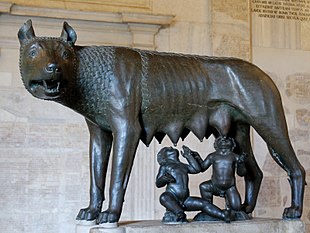
Rome's founding myth: The Capitoline she-wolf suckles Romulus and Remus, 13th century. The two boys are from the 15th century.
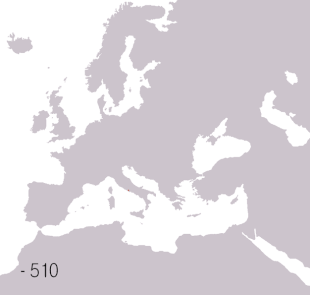
Rise and fall of the Roman Empire. (GIF animation of the territories of the years 510 BC to 530 AD). Roman Republic (509 B.C. to 27 B.C.) Roman Imperial Period (27 BC to 395) Western Roman Empire (395 to 476/480) Eastern Roman Empire (395 to 1453)

The Roman Empire and its provinces at the time of its greatest expansion under Emperor Trajan in the years 115-117
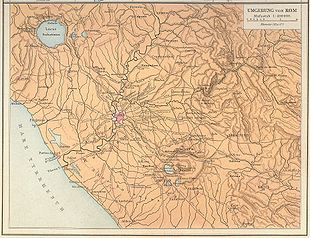
Surroundings of Rome in Antiquity (Gustav Droysen: Allgemeiner Historischer Handatlas, 1886)

S.P.Q.R. (Senatus Populusque Romanus "Senate and People of Rome"), the emblem of the Roman Republic
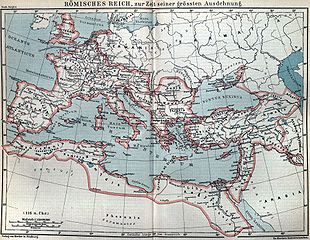
The Roman Empire and its provinces at the time of its greatest expansion under Emperor Trajan in 117 (Herders Conversations-Lexikon, 1907)

Overview of the road network in the Roman Empire in 125 AD (see also List of Roman Roads) under Emperor Hadrian: Roman Road Border of the Imperium romanum Roman military camp (legion camp) Roman city
Management
The Empire was divided into provinces until late antiquity, since the Romans had begun to extend their power beyond the mainland in the 3rd century BC (the first province was Sicily). During the imperial period, the provincial division of the empire was changed and reformed several times. Augustus divided the provinces into imperial and senatorial. Under Emperor Diocletian, the previously existing division of the Roman Empire into provinces was replaced by a new two-tier division into dioceses and provinces, which now included the Italian peninsula.
The actual backbone of the administration, however, was formed by the cities (in the legal form of colonia, municipium, civitas or urbs), which were organized as semi-autonomous civic communities and were responsible in particular for tax collection. This delegation of tasks enabled the Romans to operate with a very small central administration.
The inhabitants of the towns were not considered full Roman citizens for a long time during the Republic, but they had to serve in the Roman army and pay taxes, but they did not have the right to vote or to be elected in the Roman municipality as a whole, nor were they enrolled in the tribus. The Lex Iulia and the Lex Plautia Papiria during the Confederate War of 90 and 89 BC elevated all the country towns of Italy to the status of municipium with full civil rights, so that since then the word municipium generally meant "Italic country town".
In the imperial period, beginning already with Gaius Iulius Caesar, cities in the provinces outside Italy (but almost only in the west of the Empire) also received the right of a municipium. In the 1st and 2nd centuries there were also municipia Latina, whose inhabitants possessed Latin law, which was less comprehensive than Roman law. By the Constitutio Antoniniana of 212 AD all cities of the empire had at least the rank of a municipium, and with it almost all free inhabitants of the empire were granted Roman citizenship.
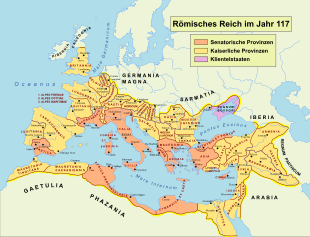
Roman provinces under Trajan (117 AD)
Economy
→ Main article: Economy in the Roman Empire
Relative peace (pax Romana) on the borders and in the interior, extensive demographic stability, freedom of movement granted to all citizens and a generally accepted and widespread monetary system were the foundations for the functioning of an empire-wide economy. Although agriculture with the latifundia economy was the basis of the Roman economy, trade and crafts also occupied an important position. A fundamental element of the economy was slavery (see Slavery in the Roman Empire).
Arts and culture
→ Main article: Roman art and Roman culture
Arts and culture reached a peak in parts of its territory during the time of the Roman Empire, especially during the imperial period; the quality of life and the corresponding level of population at that time would not be reached again in Europe and North Africa until many centuries later.
Roman art and culture developed on the basis of the down-to-earth way of life of the inhabitants of the western Mediterranean, the rather artless and sober culture of the (Indo-European) Italics who had migrated in the 2nd millennium BC and finally the Etruscans, whose culture was largely adopted by the Romans. Greek architecture, painting and sculpture, including adapted motifs from Greek mythology, served as models for essential areas of Roman art. Moreover, an equation of foreign gods (Interpretatio Romana) was a special characteristic of Roman dealings with subjugated cultures and religions, e.g. in ancient Egypt.
During its rule, Rome exerted a great influence on the areas it subjugated, especially to the north and west, in terms of art and culture. The cultures beyond its borders were also lastingly influenced, for example, by lively trade. In the eastern half of the empire, the influence of the style was mixed with existing Greek-Hellenistic and Oriental elements.
Today, the excavations in Herculaneum and the then important Roman city of Pompeii in Campania offer a comprehensive idea of art, culture and social coexistence during the high Roman imperial period. Due to the catastrophe of the sudden volcanic eruption by Vesuvius in 79 AD, they were covered with a layer of ash and pumice about 20 meters high and thus naturally preserved. Despite destruction by an earthquake in 62 AD, the excavated palaces, temples decorated with reliefs, theaters, thermal baths and entire residential quarters with their paved streets appear comparatively well preserved, as the cities were in the process of reconstruction at the time. The furnishings of the exposed houses indicate in part great prosperity of the inhabitants. The workshops of Pompeian craftsmanship were highly developed. Inside the buildings, the researchers found numerous Roman wall paintings (frescoes) and mosaics, some of them erotic, which show a high artistic level and reflect the life of a vibrant and - from today's point of view uninhibited - sensual social structure.
Pompeii was inhabited, shaped and only gradually Romanized by Oscians, Samnites, Greeks and Etruscans during the first long period of its approximately seven hundred year history. The Romans were only a part of the multi-ethnic mix for about 100 years, albeit the ruling ones. In addition, there were the slaves and migrant workers, mostly coming from eastern provinces and occupying up to a quarter of the total population. In this context, the excavated city, for example, with the temple of Isis and Aesculapius Salus, the Doric temple or the adoption of the Greek world of gods, which took place before the Romans, must also be received with the art found in Pompeii.
In addition to Pompeii and Herculaneum, the smaller towns of Stabiae and Oplontis were also completely buried. The eruption of Vesuvius was described in detail by Pliny the Younger, whose uncle Pliny the Elder perished in the catastrophe.
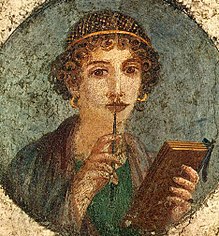
Woman with wax tray (fresco from Pompeii)

Girl playing sport in bikini, Villa del Casale, Sicily
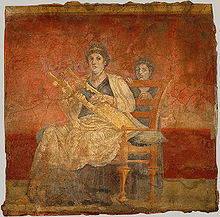
Roman wall painting from a villa in Boscoreale
Languages
→ Main article: Latin and languages in the Roman Empire
Latin, the language of Rome, spread throughout the empire as an official language. In the Hellenistic-influenced east of the empire and Egypt, ancient Greek was also the official language and was considered the language of education throughout the empire.
Other languages were also able to assert themselves as regional languages. Germanic languages were widespread in Germania inferior, Germania superior and Belgica.
The legacy of the Latin language continued to have an impact long after its demise: for centuries, Latin was the language of the educated throughout Western and Central Europe until the Baroque period. Latin gave rise to the modern "Romance" languages of Europe. In the Roman Catholic Church, Latin remains the official language to this day. Even today, Latin technical terms are used and even created in sciences such as biology, medicine and law.
Right
The legal system in ancient Rome included elementary civil and criminal procedural rules in the legal order, which in principle have been incorporated into modern legal norms. The legal system reached its highest flowering in the first centuries of the imperial period (1st - 3rd centuries). However, the legal and state system of Europe, especially civil law, is still significantly influenced by Roman law. Important points of tradition were the collections of late antiquity, such as the Codex Theodosianus and the Codex Iustinianus.
- For military law, see Military law in ancient Rome.
- For the public law system, see Roman Constitutional Law.
See also
![]()
Portal: Roman Empire - overview of existing articles, possibilities for cooperation
- List of ancient Roman emperors, list of ancient Roman kings, list of Roman consuls
- Roman mythology, Roman religion
- Women in the Roman Empire
- Roman mosaics in Britain, theater of Roman antiquity
- Food culture in the Roman Empire, bathing culture in the Roman Empire
- Roman architecture, Roman building techniques
- Roman city
- Roman Road
- Ancient historiography, senatorial historiography
- List of the largest empires and kingdoms
Questions and Answers
Q: What is the definition of Ancient Rome?
A: Ancient Rome refers to the ancient history of Roman civilization before the Middle Ages, which began with the fall of the western Roman Empire in the 5th century AD.
Q: Where was Ancient Rome located?
A: Ancient Rome was located on the Italian Peninsula and controlled a large area of land stretching from Great Britain to the Arabian Peninsula.
Q: How did Ancient Rome influence later civilizations?
A: Ancient Rome had a strong influence on later civilizations by introducing ideas from other cultures, especially those from Ancient Greece and Hellenistic kingdoms, as well as their Latin language which became common in western Europe and is an ancestor of Romance languages. Additionally, they spread Christianity across their empire during Late Antiquity and made many improvements to warfare, writing, engineering, architecture, irrigation, and transport.
Q: What religion did Romans practice?
A: The Roman emperors were responsible for making Christianity the state religion of Romans. This replaced traditional religions practiced by them previously.
Q: When did Classical Antiquity take place?
A: Classical Antiquity took place during late 3rd century BC until 5th century AD when it transitioned into Middle Ages in Western Europe due to fall of Western Roman Empire.
Q: How did Romans borrow ideas from other cultures?
A: Romans borrowed ideas from other cultures such as Ancient Greece and Greek kingdoms during Hellenistic period which helped shape their culture significantly.
Search within the encyclopedia